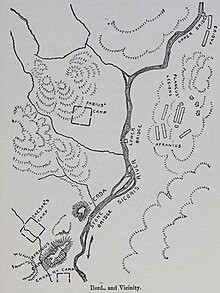Constructs such as ibid., loc. cit. and idem are discouraged by Wikipedia's style guide for footnotes, as they are easily broken. Please improve this article by replacing them with named references (quick guide), or an abbreviated title. (August 2024) |
| Battle of Ilerda | |||||||
|---|---|---|---|---|---|---|---|
| Part of Caesar's Civil War | |||||||
 Map of the first phase of the battle | |||||||
| |||||||
| Belligerents | |||||||
| Populares | Optimates | ||||||
| Commanders and leaders | |||||||
| Gaius Julius Caesar |
Lucius Afranius Marcus Petreius | ||||||
| Units involved | |||||||
| |||||||
| Strength | |||||||
|
Total: 31,000 |
Total: 36,000
| ||||||
| Casualties and losses | |||||||
| 700 killed or wounded |
200 killed Entire army surrendered | ||||||
 |
| Part of a series on the |
| Military of ancient Rome |
|---|
|
|
The Battle of Ilerda took place in June 49 BC between the forces of Julius Caesar and the Spanish army of Pompey Magnus, led by his legates Lucius Afranius and Marcus Petreius.[2] Unlike many of the other battles of the civil war, this was more a campaign of manoeuvre than actual fighting. It allowed Caesar to eliminate the threat of Pompey's forces in Hispania and face Pompey himself in Greece at the Battle of Pharsalus (48 BC).
Cite error: There are <ref group=lower-alpha> tags or {{efn}} templates on this page, but the references will not show without a {{reflist|group=lower-alpha}} template or {{notelist}} template (see the help page).